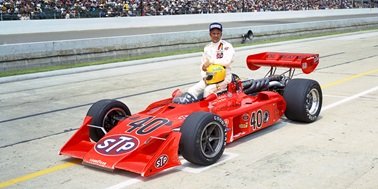Bob Harkey, who competed in the Indianapolis 500 six times between 1964 and 1976 and finished in the top 10 three times, passed away on Saturday, Jan. 16, 2016. He was 85.
Prior to his passing he was one of only 11 drivers still living who could claim to have driven in the “500” with a front-engine car. And not only was he one of only eight survivors who had started with both a front-engine and a rear-engine car, he was one of only six living who could claim a top 10 with both, backing up an eighth-place finish in 1964 with an Offenhauser-powered A.J. Watson-built “roadster” with another eighth with a rear-engined car 10 years later. He also finished 10th in 1975 when he shared the wheel with Salt Walther.
Harkey, who raced until 1983, was of the last of an era of so-called “gunfighters” who could climb into an uncompetitive car on the final day of “500” qualifications and “brave it into the show.” If time was running out and a team was struggling to make the race, he would be right at the top of the list of drivers to call upon.
A competitor in 84 USAC (United States Auto Club) National Championship events between 1963 and 1979 – he placed fourth in the July 1964 event at Trenton, New Jersey – Harkey had aspired to compete in the Indianapolis 500 since boyhood. But there had been a major hurdle to overcome. By the time he felt the calling, the standard route for a driver to earn his way to the Indianapolis 500 was by success in working up through the open-wheel ranks of sprint cars and midgets. The problem was that Harkey was born and raised in Charlotte, North Carolina – deep in stock car country – and trying to find any kind of open-wheel racing in which to compete was quite a challenge.
One solution was to compete in NASCAR’s short-lived midget division, which he did, finishing seventh in points in 1956 and winning the Ford-powered midget division title in 1957, his colorful car owner being Bus Brosenne, a landscaper at the White House. After placing eighth overall in 1958 and winning the NASCAR Florida midget title in early 1959, Harkey decided to pursue one of the other options, which was to travel north.
He lived for a short time in Gary, Indiana, while campaigning Chicago-area midgets with UARA (United Auto Racing Association), and then he relocated to Poughkeepsie, New York, where he raced midgets with ARDC (American Racing Drivers Club) and sprint cars with URC (United Racing Club). In UARA, he was an occasional teammate of eventual multi-national midget champion and Indianapolis 500-bound Mel Kenyon, while on his way to finishing fifth in ARDC points in 1962, he found himself frequently battling with 22-year-old Mario Andretti, these two finishing one-two to each other on several occasions. On June 3 of that year, Harkey had demonstrated his strength and extreme stamina by finishing fourth in a midget race at Trenton, New Jersey, the distance being 250 miles!
The colorful Harkey led a most interesting and diversified life, performing as an aerial stunt pilot at county fairs (wing-walking and performing loop-the-loops); as a stunt man in several motion pictures, and he even boxed as a professional, claiming he once fought Floyd Patterson as an amateur in a Golden Gloves contest. He performed all the stunts for Robert Mitchum in “Thunder Road,” was one of the drivers in “Winning,” starring Paul Newman, Joanne Woodward and Robert Wagner, and also performed stunts in “Speedway” with Elvis Presley.
In February 1959, he took part in the very first event at the then-brand new Daytona International Speedway, not in the inaugural Daytona 500, but rather in the supporting 100-mile convertible race in which he drove a car for Buck Baker, starting sixth and taking over the lead on Lap 5 by passing a very young Richard Petty. He finished 10th.
Later the same year, he was one of several ARDC drivers who threw caution to the wind and drove a midget against a variety of open-wheel road racing cars and sports cars in a Formula Libre event over the road course at Watkins Glen, New York. He finished well back, but fondly recalled that the great British driver Stirling Moss, who won in a rear-engined Cooper-Climax, would routinely give a little wave of acknowledgement to any courteous driver he happened to be lapping, Bob included.
For 15 years, starting in 1964, Harkey was part of Champion Spark Plug Company’s extremely popular Highway Safety program in which “500” drivers would tour the country giving lectures on safe driving tips at high schools and military bases. He claimed to have visited 36 states during his tenure and likely spoke to more than one million people. It was not at all unusual to have someone come up to Harkey at a track or at a function in recent years and thank him for having visited their school when they were a student.
Harkey had a deep passion for aviation history and would travel great distances to visit museums, attend air shows and meet retired combat pilots. In fact when asked what he would like to have been if not a race driver, he would respond, “a World War One fighter pilot!”
A lasting memory of the man took place shortly after the conclusion of the final qualifying day at Indianapolis in 1979. He had ending up missing the show, but fellow driver John Mahler had made it, doing so at the very last minute and in truly dramatic fashion. Mahler had qualified a car earlier, subsequently been “bumped” and then had come back with a hastily prepared “backup” car to “brave it in” at the last moment. As he staggered through the Garage Area a few minutes later, hair mussed and a look of shock and bewilderment on his face, out of the crowd and into Mahler’s path stepped Harkey. They looked at each other and not a word was uttered as a decidedly wild look materialized in Harkey’s eyes and a menacing grin spread across his face. Mahler responded by duplicating Harkey’s facial expressions and the two of them just stood there, oblivious to anyone else, grinning at each other and emitting earthy chuckles as they shared a terrifying experience few human beings on the planet could possibly have comprehended.
Bob Harkey will be sorely missed. He was a most interesting character who could keep a listener constantly entertained with stories about racing and aviation and stunt work, all of it laced with colorful rapid-fire witticisms.
He is survived by wife Cheryl, a daughter, Robyn, and several cousins.
Arrangements are pending.
A Tribute to Bob Harkey, 1930-2016

Bob Harkey, who competed in the Indianapolis 500 six times between 1964 and 1976 and finished in the top 10 three times, passed away on Saturday, Jan. 16, 2016. He was 85.
Latest News
View All News
BorgWarner, Unser Help ‘Wreath Lady’ Celebrate 33 Years of Tradition
Two-time Indianapolis 500 winner Al Unser Jr. (photo, left) presented a signed poster to BorgWarner winner's wreath creator Julie Vance (photo, right).

INDYCAR SERIES Race Winner, Longtime Official Dallenbach Dies at 87
Wally Dallenbach drove to five INDYCAR SERIES victories and was the highly respected chief steward of the INDYCAR SERIES for more than 20 years.

Indy 500 Décor, Community Initiatives Celebrate, Extend Iconic Month of May
May is community, and nothing brings people together like the stunning art and fan-friendly events that signal “This is May” throughout Central Indiana.
